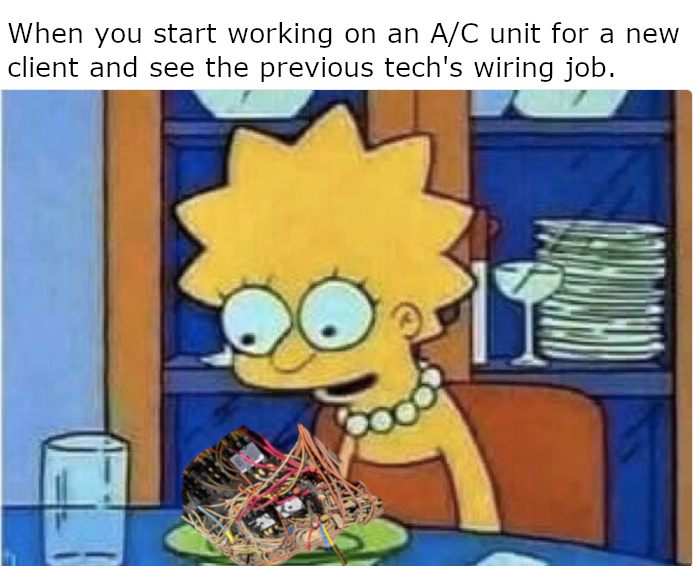Get Tech Tips
Subscribe to free tech tips.
The Pressures Look Good

Yeah? Well, how do you know? What should they be? What are the outdoor and return air temperatures? What SEER rating is the equipment?
These are the questions I ask every single time a technician says the phrase,
“But the pressures look good for [insert refrigerant of choice here].”
When they can’t answer the questions above, I often respond with Jim Bergmann’s line:
“If you don’t know what the pressures should be, what difference does it make what they are?”
The truth is, we can know what the pressures should be under a given circumstance. But we first have to know what the given circumstances are and why they are relevant. We’ve talked before about design temperature difference (DTD) and condenser temperature over ambient (CTOA), and you can find these past discussions HERE and HERE. Let’s review:
DTD: How much cooler the refrigerant in the evaporator is by design compared to the return air passing over the coil. For nearly all systems, the DTD is 35°F +/-3 below the return air temperature.
CTOA: How much warmer the refrigerant in the condenser is based on SEER compared to the outdoor air temperature.
- 6-9 SEER (Older than 1991) = 30°F CTOA
- 10-12 SEER (1992 to 2005) = 25°F CTOA
- 13-16 SEER (2006 to present) = 20°F CTOA
- 17+ SEER (2006 to present) = 15°F CTOA
If you’re arriving for routine maintenance, put your gauges/probes away, and don’t pull them out unless things are out of range. You can use non-invasive system testing (NIST… AKA checking the charge without gauges) at that point.
But DTD and CTOA are where we start when we arrive at a system we’ve never worked on before because we will need to gauge up in order to benchmark the system. The following is an example of how to use these concepts to determine what the pressures should be before you hook up your gauges:
Outdoor Ambient Temp: 88°F
Return Air Temp: 74°F
SEER rating of equipment: 15
Refrigerant Type: R410a
Liquid Line Pressure:
We know the SEER rating of the equipment is 15, so we refer back to the list above to find which CTOA value should be used. In this case, we have a 20°F CTOA.
88°F + 20°F = 108°F sat
At this point, we’ve calculated what the saturation temperature of the refrigerant should be under these outdoor conditions. We can now refer to a pressure-temperature (PT) chart to determine the corresponding pressure at 108°F. The Danfoss Ref Tools (previously Refrigerant Slider) app is perfect for this. The liquid line pressure at 108°F saturation temperature is 356.5 PSIG.

This screenshot of the Ref Tools app shows the liquid line pressure of R410A at saturation at 108°F. Notice how the slider has been set to BUBBLE point (inside the orange box).
Vapor Line Pressure:
Again, we already have the return air temp data, which is 74°F. The design temperature difference is (DTD) 35°F.
74°F – 35°F = 39°F sat
Now, we have calculated what the saturation temperature should be inside the evaporator under the given circumstances. Referring back to the Ref Tools app, we find that the corresponding pressure is 116.1 PSIG.

This screenshot of the Ref Tools app shows the vapor line pressure of R410A at saturation at 39°F. Notice how the slider has been set to DEW point (inside the orange box).
Before we even hook up our gauges/probes, we know the system operating pressures should be within +/- 10 PSI of:
Liquid Pressure: 356.5 PSIG
Vapor Pressure: 116.1 PSIG
It should be noted that when using a zeotropic refrigerant (any refrigerant made up of two or more different types of refrigerants, each with different boiling points), care should be taken to observe the bubble point and dew point. R410a is considered a “near-azeotropic” refrigerant (a refrigerant mixture of two or more refrigerants, each with the same boiling point). But if we were to work on a system with R407C or basically any other 400 series refrigerant, the glide (the discrepancy between the boiling points) is much higher.
The thing to keep in mind is this:
For liquid pressure on zeotropic blends, use the bubble point. For vapor pressure on zeotropic blends, use the dew point. If we eventually want to calculate what the line temperatures should be on a system, we will need to use target superheat and subcooling. Superheat is measured on the suction line. Subcooling is measured on the liquid line. A simple way to help you remember whether you need to use bubble point or dew point is to think: Bubcooling and Dewperheat.
Next time you arrive at a service call, find out what the pressures should be. Soon, you will be checking charges without gauges!
For more in-depth information on bubble and dew point, here’s a video on the subject, along with a list of further resources:
https://hvacrschool.com/podcasts/blends-and-midpoint-w-jim-bergmann-2/
https://hvacrschool.com/glide-at-static-pressure/
https://hvacrschool.com/mid-point-refrigerant-blend/
-Kaleb











Comments
Great info!
Charge the phone!
Great info!
Charge the phone!
Great right up, just make sure the airflow is in range!
Great right up, just make sure the airflow is in range!
Great article, just make sure the airflow is in range!
Great article, just make sure the airflow is in range!
I use A.B.C.D.E. to remember Azeotropes Bubble in Condenser, Dew in Evaporator.
I use A.B.C.D.E. to remember Azeotropes Bubble in Condenser, Dew in Evaporator.
To leave a comment, you need to log in.
Log In